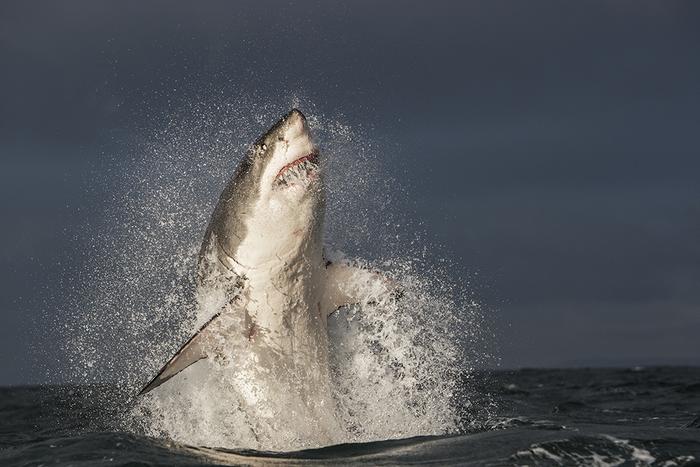The mysterious disappearance of great white sharks from South Africa’s False Bay has set off a chain reaction throughout the marine ecosystem, according to a groundbreaking 20-year study published this week in Frontiers in Marine Science.
Researchers from the University of Miami have documented how the absence of these apex predators has disrupted the delicate balance of marine life, with effects rippling down through multiple levels of the food web in ways that confirm longstanding ecological theories about predator-prey relationships.
“The loss of this iconic apex predator has led to an increase in sightings of Cape fur seals and sevengill sharks, which in turn has coincided with a decline in the species that they rely on for food,” said Neil Hammerschlag, Ph.D., the study’s lead author from the University of Miami Rosenstiel School of Marine, Atmospheric and Earth Science.
The study, which began in 2000, tracked a dramatic decline in white shark populations starting in 2015, culminating in their complete disappearance from the area by mid-2018. While researchers can’t pinpoint the exact cause, they note that years of shark captures in protective nets and more recent predation by orcas likely contributed to their disappearance.
What happened next offers a rare glimpse into how marine ecosystems respond when top predators vanish. After white sharks disappeared, Cape fur seals—formerly prime prey for the sharks—increased dramatically. Reports of seal sightings rose by 520% in the area, and seals began ranging much farther across the bay than before.
With fewer sharks to worry about, seals expanded their hunting activities, resulting in a measurable decline in Cape horse mackerel, a key prey species for seals. The research team documented a 44% reduction in summer populations of these fish.
Simultaneously, sevengill sharks—which had historically avoided the area due to predation by white sharks—moved in to fill the ecological void. Their presence skyrocketed from being completely absent in boat-based surveys before the white shark decline to becoming a common sight afterward.
This influx of sevengill sharks created its own cascade of effects. Smaller shark species that serve as their prey, including pyjama catsharks and smoothhound sharks, declined by 72% and 42% respectively.
“The use of underwater video surveys conducted more than a decade apart provided us with a snapshot of the food web both before and after the disappearance of white sharks from False Bay,” explained Yakira Herskowitz, co-author and former graduate student who analyzed the underwater footage. “The number of individuals of a given species recorded on the videos not only informs us about their numerical abundance, but also their behavior, as species under increased predation risk often become more elusive and are thus less likely to be detected on our cameras.”
What makes this study remarkable is that it offers real-world evidence supporting the “trophic cascade” theory—the idea that changes at the top of a food web can trigger rippling effects through lower levels. Previous research on such cascades in marine environments has been limited, largely due to challenges in studying vast ocean ecosystems.
The research team employed multiple methods to document these changes, including standardized boat-based surveys around Seal Island, citizen science observations, and underwater video stations positioned throughout False Bay.
The magnitude of these ecological shifts varied in a pattern consistent with trophic cascade theory. The largest shifts occurred in species directly impacted by white sharks (seals and sevengill sharks), with progressively smaller effects observed in species farther down the food chain.
While the research focuses on a single bay in South Africa, its implications stretch globally. Shark populations worldwide face increasing pressure from fishing, habitat loss, and climate change. If the False Bay scenario plays out in other marine ecosystems, the consequences could be far-reaching.
“Without these apex predators to regulate populations, we are seeing measurable changes that could have long-term effects on ocean health,” Hammerschlag noted.
The findings underscore the critical role that apex predators play in maintaining marine biodiversity and highlight the need for increased conservation efforts to protect these vital species before more ecosystems experience similar disruptions—a sobering reminder that in nature, everything is connected.
If our reporting has informed or inspired you, please consider making a donation. Every contribution, no matter the size, empowers us to continue delivering accurate, engaging, and trustworthy science and medical news. Independent journalism requires time, effort, and resources—your support ensures we can keep uncovering the stories that matter most to you.
Join us in making knowledge accessible and impactful. Thank you for standing with us!


“These findings underscore the critical role that apex predators play in maintaining biodiversity & the need to protect these vital species before more ecosystems experience similar disruptions (collapse.) This study offers real-world evidence that changes at the top of a food web, (a/k/a the web of biological life on Earth) can trigger rippling effects through lower levels.” (Paraphrase)
I believe Hammerschlag, Herskowitz, Miami U & Science Blog, are all pulling our leg bc the need for diversity of biological animal & plant life on this planet is known for as long as I remember. Tho’ It doesn’t mean anything to politico leaders who run the world & cater to a fraternity of humanity (in every global nation) who keep killing off diverse whole species of non-human animals while breeding a ‘single human species’ into limitless billions, that Earth’s resources were not meant to sustain.
We swear, no leg pulling here! But your point is taken. What do you think would be a better use of research resources?